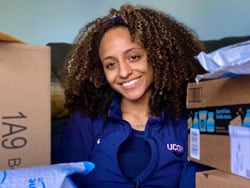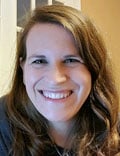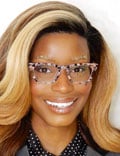
Aaliyah Riccardi was stunned by gifts from doctors she’s never met.
When Aaliyah Riccardi, a fourth-year medical student at the University of Connecticut, got home from her rotations, she found four packages on her doorstep. She thought there had been a mistake. There wasn’t. The new mixer, the textbook, and contents of all the other packages were for her. The next day, she got four more…
She had tagged a post with #MedGradWishList on Twitter, at the urging of her mentor, but never thought anyone would actually buy her anything. She was soon surrounded by graduation gifts and notes from people she had never met. Riccardi says she was overwhelmed by “all the random love for someone so early in their career.”

Dr Jennifer Rubin
The idea to celebrate new colleagues came to Jennifer Rubin, MD, a child neurologist at Northwestern Medicine in Chicago, while she was buying a stethoscope. She had recommended the tool to a soon-to-be graduate on Twitter, and the student responded by telling Rubin that they were “adding it to their grad wish list.” Rubin sent a direct message to the student, offering to buy the stethoscope.
“It was kind of a great way to support someone going into residency,” Rubin said. Although helping one student felt good, thousands of other graduates were on her mind. “It’s been a rough year for everyone,” she said. “I was just imagining how hard it is to be in med school to begin with and on top of that to face systemic racism.”
So Rubin asked her Twitter followers if anyone would be interested in specifically celebrating and thanking their soon-to-be colleagues of color with graduation presents?
The response was overwhelming, and #MedGradWishList was born.
The Gift of Hope

Farrah-Amoy Fullerton, a UAB med student, is helping with the #MedGradWishList effort
Farrah-Amoy Fullerton, a fourth-year medical student at University of Alabama Birmingham, saw the hashtag and made a list of her own. While trying to juggle her final rotation and bear the anxiety of the upcoming residency match, Fullerton immediately saw the potential in Rubin’s idea. While Rubin managed attending physicians and other donors, Fullerton started gathering and organizing student wish lists.
Rubin’s and Fullerton’s inboxes were soon inundated with queries from interested students and donors. “I feel very fortunate that Farrah-Amoy got involved when and in the way she did,” Rubin said. Fullerton embraced #MedGradWishList “in the spirit which it was intended” and truly allowed it to flourish, Rubin explained.
Fullerton says that it’s hard for med students to ask for help, “especially for Black people.” Both the medical community and the Black community place emphasis on “pulling yourself up by your own bootstraps,” she said. Part of the rationale behind #MedGradWishList is showing that it is okay to ask for help and to ask for what you deserve, says Fullerton.
Organizers have now collated around 280 wish lists, so donors can directly purchase gifts for students. Rubin has also collected over $7000 dollars from anonymous donors used to provide gifts for more than 80 students.
Student wish lists include everything from stethoscopes to bed frames, pens, and vacuum cleaners. Many have major moving expenses coming, just as their med school loans run out. Costs of the physical move — like transportation and apartment deposits — take precedent over the things they need to practice medicine and furnish a home.
Recipients say that the infusion of hope the project has brought couldn’t be more timely. Interview season has just ended for the soon-to-be graduates and they are now anxiously waiting to see where (or if) they matched. Due to the pandemic, many have never visited the cities and hospitals they will soon call home. COVID has also canceled the usual celebrations of graduation and Match Day that they’ve looked forward to for years.
On top of that, recent events have left many minority students even more on edge about the possible conditions of their residency. From a controversial JAMA podcast about racism in medicine to Tulane’s removal of Princess Dennar, MD, from her role as residency program director after she filed a discrimination lawsuit, Black med students have seen plenty of headlines with the potential to give them pause about their career.
Although one action or movement can’t fix systemic issues, “#MedGradWishList has been this huge, two-week long celebration that’s tangible,” says Alana Nichols, JD, MD, one of the student co-organizers. Stress and discomfort are not something students want to complain about right now, Nichols says, but this trend has validated their struggles.
For example, just a few hours after the movement began, a med student at the Mayo Clinic sent her wish list to Londyn Robinson, a fourth-year student at the University of Minnesota, in hopes of a retweet. The Mayo student’s laptop was broken. With no income and loads of upcoming expenses, she couldn’t afford to replace it. “It dawned on me that the probability of a single donor buying a $1300 laptop is really slim,” Robinson said. “So I said, ‘Let’s fundraise for it!’ “
Robinson donated $50 herself and put a call out on #MedGradWishList for more help. Within an hour, donors had raised enough money to buy a MacBook. Robinson immediately connected with Nichols about the possibility to keep fundraising for students. Together, they amassed a list of 120 students who need a computer. Thus far, they have leveraged their Twitter followings to raise enough money for almost 20 laptops.
Over the past week, Robinson often wakes up to find that enough money was sent to her Venmo account to buy another laptop while she slept. Once they’ve crowdsourced enough funding, they use a random number generator to pick a student from their spreadsheet.
“It’s been a way to have camaraderie during a difficult time,” Robinson said. It has also been a way for attendings and professionals “to support people who will be direct care providers in mere months.”
Pushback and the Bigger Picture
Despite the positive intentions and the enthusiastic response from students who received gifts, there have been some obstacles. Early on, the original online shared spreadsheet was tampered with. Student links had been replaced with dummy links. Specifically, it appears that links to students from historically black colleges and universities (HBCUs) had been specifically targeted, Fullerton said. Fullerton and Nichols have since spent many hours repairing and authenticating the new list.
Critics have also condemned the inclusion of more expensive wish list items. Some on Twitter have called for students to be more reasonable in their wishes, saying laptops and iPads are too costly. “But that’s not how wishing works,” Nichols said. She encourages participants to include whatever they want.
Fullerton put a bed on her own wish list. She had never owned one. She had one at her parents’ house and rented the one in her current apartment. Putting such a personal item on her list “felt like wearing my heart on my sleeve,” she said. She never expected anyone would actually buy it. When someone did, she broke into sobs. “I put my heart out there, and it was treated with such care,” she said.
Recipients have taken to Twitter to thank donors and organizers. Rubin’s hope is for the recipients to understand what a joy it is for the attendings and other donors to give. “I think it’s been lovely. We are able to shower them with gifts and love and thank yous.”
#MedGradWishList has flourished more than any of the founders could have hoped. Still, no matter how successful it is, the movement “doesn’t at all negate the fact that we intend to call institutions to task for their processes,” Nichols said. This moment of supporting students has offered much-needed celebration during a terrible year, she says, but those same students are still at risk for having a toxic residency. Minority students are significantly more likely to leave a job due to discrimination, Robinson said, quoting the Accreditation Council for Graduate Medical Education (ACGME): “Medicine as a profession is still racist.”
Although systemic change is still the long-term goal, efforts like “#MedGradWishList provide something a 10-year process can’t, and that’s hope” says Nichols. “Sending me a gift card doesn’t dismantle racism at your institution. But receiving that gift while I battle racism, that’s a reminder that there are people out there supporting me.”
Moving forward, all involved are hopeful that this will become an annual effort. It has been a time-consuming undertaking for everyone involved. Fullerton is already trying to simplify the process so it can be easily passed along. With more planning, Rubin also hopes to assemble a larger team, so that the burden of labor doesn’t fall on just a few. “I don’t want this to require the Black community to do more labor. The purpose is to thank them for their labor.”
Fullerton feels the true ramifications of entering medicine in this positive fashion won’t be seen until her class are attending physicians. And she expects big things from herself and her peers. “The class we have now is going to be responsible for some of the most dramatic changes in medicine and the culture of medicine.”
Donavyn Coffey is a freelance journalist who covers health and the environment from her home in the Bluegrass. Her work has appeared in Popular Science, Insider, and SELF.
For more news, follow Medscape on Facebook, Twitter, Instagram, and YouTube.
Source: Read Full Article
